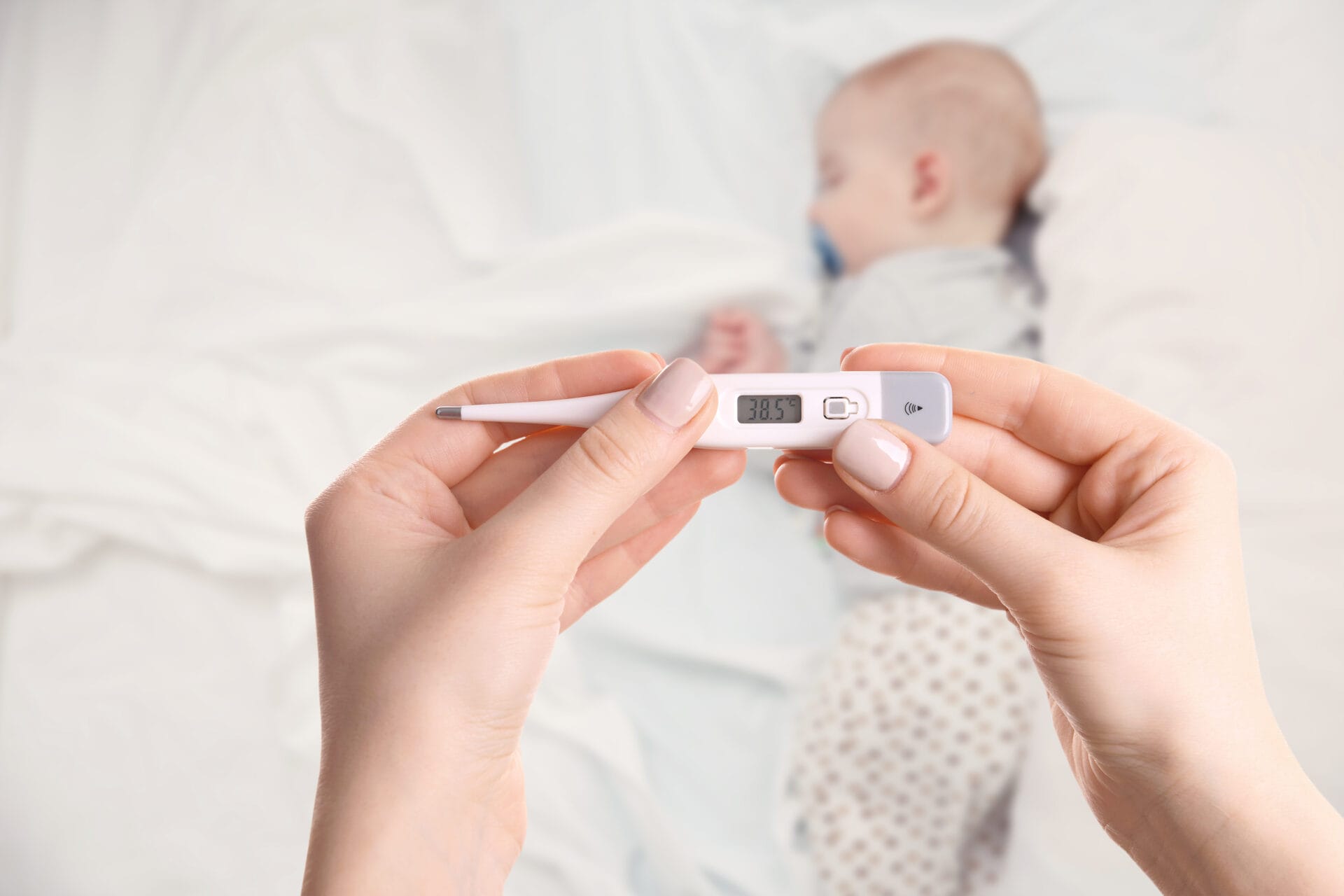How to choose the right thermometer for my baby
Last updated on March 15, 2024


Choosing the right thermometer for your baby is an essential part of your parenting toolkit, especially in those early years when children are most vulnerable to fevers and illnesses. As a parent, it’s natural to feel overwhelmed by the array of options available in the market.
For infants under three months, a rectal temperature measurement (using a rectal thermometer) is the only reliable way to assess their temperature. For older babies and children, you can use digital thermometers under the arm, forehead or ear thermometers. Proper usage and consideration of your baby’s comfort are essential, and it’s advisable to consult a healthcare professional when in doubt about your baby’s health.
Here’s what you need to know when choosing a thermometer for your household.
Rectal temperature reading on a digital thermometers
A standard digital thermometer inserted into the baby’s rectum provides the most accurate temperature reading, according to pediatricians. That said, undressing your sick baby in the middle of the night to insert a cold probe into their bottom may not go over so well.
- May be used on: Anyone. Safe for babies less than three months old.
- Pros: Accurate. Inexpensive. Often available at a grocery store or drug store open late.
- Cons: Slow readings can take up to ten seconds. Difficult to execute. Necessary to wake baby. Must re-insert the thermometer to get a second reading for confirmation.
Good to know: If you choose to use a digital thermometer for rectal readings on your newborn, don’t forget to label the thermometer “Rectal” and purchase another thermometer to use for oral temperature readings.
No-contact forehead thermometers
Also known as infrared or temporal artery thermometers, no-contact forehead thermometers are a top choice for a sleeping baby* — these may be aimed at the baby’s forehead for a non-invasive, quick temperature reading of your baby’s skin. Stay less than one inch away without touching the forehead. Don’t forget that some doctors add .5 – 1.0 degree to the temperature to make a no-contact reading equal to a rectal reading.
- May be used on: Anyone.
- Pros: Easy to use, quick temperature reads. Most comfortable option for the baby. Less intimidating for babysitters or other caregivers.
- Cons: Can be expensive. May be less accurate than contact oral or rectal temperature readings.
- Good to know: For the most accurate readings, turn on your thermometer and let it warm up for fifteen minutes. If your thermometer has an “alert” setting, don’t forget to turn it off for noise-free temperature taking in the event your baby is asleep. If your baby has been wearing a hat, remove the hat for fifteen minutes to get a more accurate reading. The key with these thermometers is consistency. They can be sensitive to environmental temperatures as well as skin temperature.
*Keep in mind that fevers usually spike at night because there is less cortisol in the blood, which means the white blood cells can detect infection more easily.
Forehead touch thermometers
A great choice for a baby or child of any age, these thermometers have a metal sensor on the end that must be in contact with your baby’s forehead in order to get a reading.
- Pros: Inexpensive, accurate (as long as your baby can be still). Quick readings.
- Cons: Difficult to use on a wiggling baby. Will wake a sleeping baby. Requires your baby to stay still for the highest level of accuracy.
Good to know: Plan to do three or four forehead swipes to compare the numbers
Additional options for babies over three months
Here are a few more options for taking the temp of a baby who is over 3 months old:
Ear Thermometers: For all the parents out there who love a good medical drama, using an ear thermometer for temperature readings can make you feel like you’ve got your own M.D. These thermometers measure heat coming off the eardrum.
- Pros: With some finesse, may be used on a sleeping baby. Takes less than 2 seconds. Does not require child or baby’s cooperation. Does not cause discomfort.
- Cons: Can be tricky to use at first. We do not recommend using an ear thermometer for the first time in the middle of the night. Trust us!
- Good to know: Baby must be inside for at least fifteen minutes to get a good reading.
Underarm temperature readings: Using a standard digital thermometer to take your baby’s temperature can be a great option – with a catch. Underarm readings, if done correctly, indicate fever for a reading over 99 F (37.2 C) or higher.
- May be used on: Babies over six months for most accuracy
- Pros: Inexpensive digital thermometer
- Cons: Sensor must stay in contact with baby’s underarm for ten seconds. Baby’s torso must be undressed in order to get skin contact. If your baby moves or rejects the thermometer, starting over can be difficult.
- Good to know: Hug your baby while the thermometer is running to ensure contact with the sensor is maintained.
NOTE: It’s never safe to use a mercury glass thermometer. Contact your local sanitation department to dispose of your mercury thermometer if you find one at home.
Ultimately, the most important thing is to use the thermometer correctly according to the manufacturer’s instructions. If you have concerns about your baby’s health or are unsure about how to use a particular thermometer, it’s always a good idea to consult with your pediatrician or a healthcare professional for guidance.


Reviewed by Dr. Gilson Capilouto & Dr. Jessie Zak
Next Article

